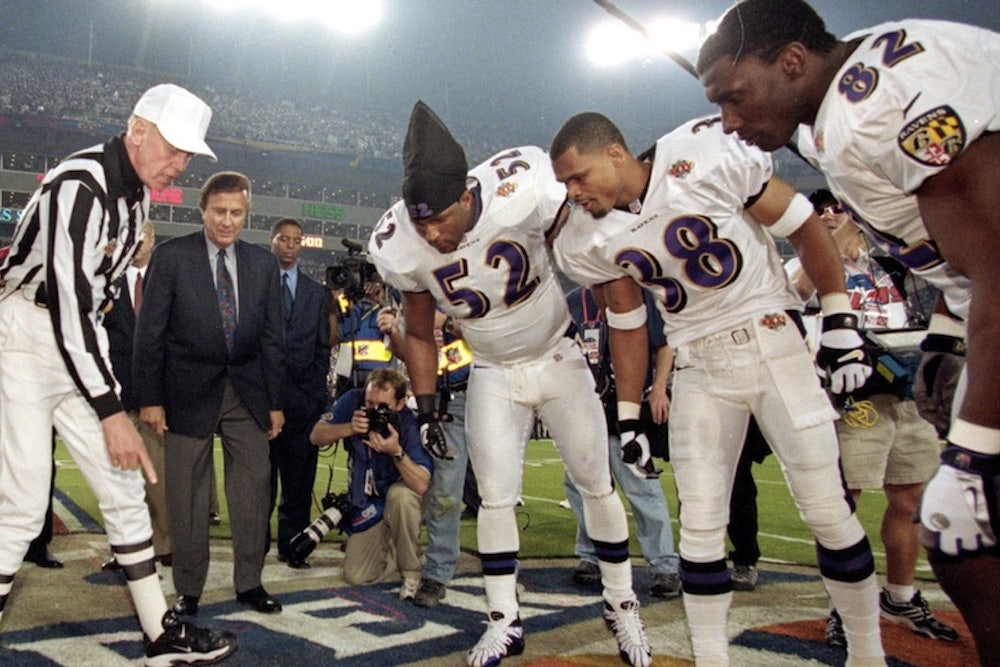If historical precedent is anything to go by, there’s as good a chance the Seattle Seahawks will call “Tails” as “Heads” when they take to the field on Sunday for the NFL’s opening coin toss; out of 47 Super Bowls, “Heads” and “Tails” have been called 24 and 23 times, respectively. But if you flip a coin for five people on the street and ask them to call “Heads” or “Tails,” four of them will pick “Heads.”
Why do ordinary people behave so differently from football captains? It may have to do with how the “Heads” vs. “Tails” dilemma is presented. At the outset of the Super Bowl, the referee rarely frames the coin toss as a simple “Heads or Tails” choice, like the man on the street would; instead, there’s a song and dance about the Super Bowl’s special “commemorative” coin. A new paper, forthcoming in the Journal of Experimental Psychology: Learning, Memory and Cognition, examines the root of the “Heads” bias—and finds coin-flippers can manipulate and even reverse people’s predictions just by tweaking the way they pose the question.
“Analysis of several existing data sets reveals that about 80 percent of respondents start their sequence with Heads,” explained psychologist Maya Bar-Hillel, a cognitive psychologist at the Hebrew University of Jerusalem who led the study. “We attributed this to the linguistic convention describing coin toss outcomes as ‘Heads or Tails’, not vice versa. However, our subsequent experiments found the ‘first-toss’ bias reversible under minor changes in the experimental setup, such as mentioning Tails before Heads in the instructions.” In other words, simply rearranging the phrasing of the question caused drastic changes in behavior.
Experiment Round 1: Confirming the Initial Heads Bias
In their first experiment, Bar-Hillel and her colleagues confirmed the existing data on the Heads bias. They recruited 175 participants and asked them to predict whether each of ten coin tosses would “result in Heads or Tails.” As they expected, 79 percent guessed that the first coin would land heads-up. Some of the participants were offered a monetary bonus for guessing right; this had no effect on their answers.
Bar-Hillel and her team then set up a series of experiments to test different variables that might explain the Heads bias. “The linguistic convention ‘Heads or Tails’ is a given that cannot be easily manipulated,” they wrote. “But tasks asking people to predict coins needn’t follow it: instructions can mention either Heads or Tails first, and response formats can show either the Heads or the Tails column first (namely, to the left).”
Experiment Round 2: Manipulating Coin Tosses
Bar-Hillel recruited 248 participants and found, to their surprise, that they could manipulate respondents’ first-toss bias by changing the wording of their instructions. If respondents were told to “enter H for Heads,” 87 percent entered “Heads”; if they were told to “enter T for Tails,” 69 percent put down “Tails.” “The conventional order exerts its influence on the first toss,” though, “even when the Heads bias is reversed. Other things equal, conditions favoring Heads created a stronger bias than those favoring Tails.”
To test the pure effect of sequence, the researchers discarded the terms “Heads” and “Tails” and introduced new terminology that came unloaded with cultural assumptions: they asked subjects to imagine a coin that was purple on one side and orange on the other. Half the subjects were told that the coin was “purple on one side, orange on the other”; the other half was told about a coin colored “orange on side, purple on the other.” For their first pick, between 80 and 92 percent of respondents predicted the coin would land on color they heard first.
What if the psychologists make no mention of “Heads” or “Tails,” “orange” or “purple”? When participants were told simply to “predict what each [of ten] toss[es] will result in,” 82 percent guessed heads— suggesting that the conventional order of “Heads and Tails” is pretty entrenched, and making it even more surprising that the researchers could overcome it.
